

Babadua benfra. (Asante hinged bracelet), cast gold, 7.9 cm. This design represents the segmented cane babadua and is usually associated with queen mothers, strength, and resilience. Ex Rudolf and Leonore Blum, Zumikon, Switzerland

Asante chief’s bracelet. “You have watches, we have time”- Akan proverb. Gilded Silver alloy. This mimics a western watch and reflects the power and authority of the ruler, who can control time. Non functional- worn as a symbol of the message and status. Gallery Walu, Basel, Switzerland before 1995.
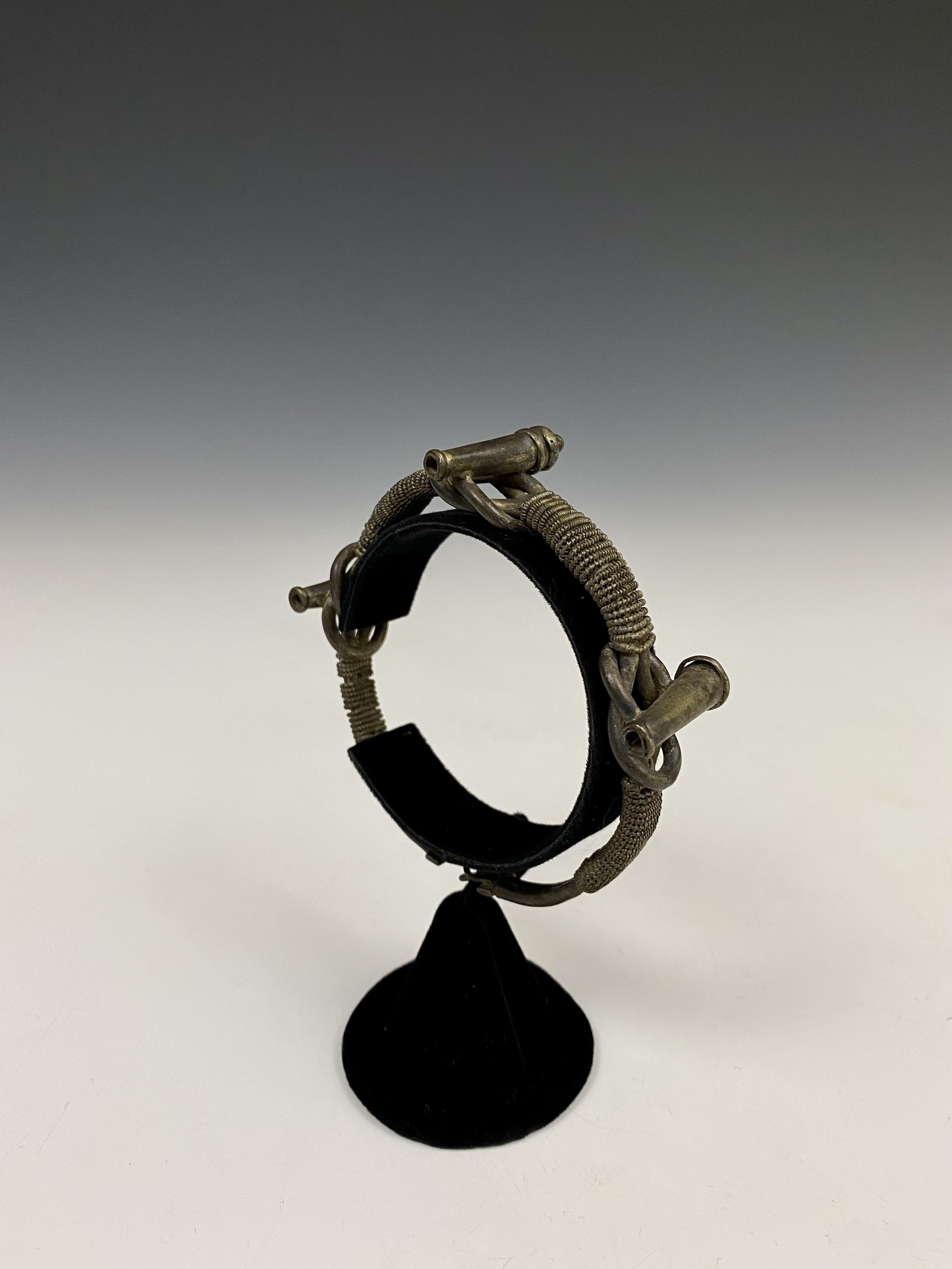
Asante silver bracelet with 3 cannons representing strength and readiness on top of 3 wisdom knots "NYANSAPO"- the symbol of wisdom, ingenuity, intelligence and patience. "An especially revered symbol of the Akan, this symbol conveys the idea that "a wise person has the capacity to choose the best means to attain a goal. Being wise implies broad knowledge, learning and experience, and the ability to apply such faculties to practical ends." From the estate of René David (1928-2015), Zurich. Exhibited: Musée International du Golfe de Guinée, Togo (2005-2011).


Asante chief’s ring “mpetea”. Lost wax cast gold, Ghana. H 2.36”. One goldsmith in Kumasi named this ring as ahwehweba. Other people in Kumasi thought that it represented the proverb: Ti koro nko agyina. “One head does not make a council.” (There should be consultation when an important decision is to be made). Provenance: Galerie Walu, Zurich, Switzerland. Estate of Dr. Andreas Vontobel (1931-2011), Waltalingen, Switzerland

Akan/Asante chief's ring "mpetea" with blossom - Ghana. gold alloy ca. 0,65 0 (15.6 karat), weight: 27 g, H: 1.4 inch; ID: 0.8 inch (inner) Proverb associated: “Leaves of two kinds of kola we gather with wisdom .” Meaning “The leaves of the two kinds of Kola are very similar and it needs skill and experience to separate them. You have to take care in dealing with problems, and separate them carefully. -D. Ross. Provenance: Zemanek-Münster, Würzburg, German, Roland Hartmann, St. Gallen, Switzerland, René David, Zurich, Switzerland.

Akan chief's ring "mpetea" with a mudfish motif, Ghana. Cast gold alloy 0,570 (13,68 carat), weight: 25,8 g, H: 5,2 cm; W: 5,6 cm; D: 1,7 cm, H: 2,0 inch; W: 2,2 inch; D: 0,7 inch. Associated proverb: "When the mudfish swallows anything, it does so for its master" (crocodile), that is, what is good for his subjects is good for the chief". Provenance: Zemanek-Münster, Würzburg, Germany, Roland Hartman, St. Gallen, Switzerland, René David, Zurich, Switzerland

An Akan chief’s ring “mpetea” in the form of the mudfish. Ghana. Cast Gold alloy, H: 4,3 cm; W: 5,5 cm; D: 2 cm, H: 1,7 inch; W: 2,2 inch; D: 0,8 inch. I particularly like the head pattern on this example. Associated proverb: "When the mudfish swallows anything, it does so for its master" (crocodile) that is, what is good for his subjects is good for the chief". Provenance: René David, Zurich, Switzerland, Roland Hartmann, St. Gallen, Switzerland, Zemanek-Münster, Würzburg, Germany.

Akan Chief's ring "mpetea" of a mudfish - Ghana. Cast Gold/ silver alloy. H: 2.0 inch; W: 2.4 inch; D: 0.8 inch. EX Zemanek-Münster, Würzburg, Germany, EX Roland Hartmann, St. Gallen, Switzerland, EX René David, Zurich, Switzerland

An Asante chief’s ring “mpetea” of a bird with cannons at the base of each wing and a powder keg in its beak and on its tail. Cast gold alloy, H 4 cm, Ghana. “One of the most explicit, if fanciful, symbols of power found on Asante sword ornaments is a bird with cannons on its wings and often a keg of gunpowder on its back and in its beak. The body of the bird is typically configured as a square knot (nyansapɔ), a symbol of wisdom and the ability to solve problems among the Akan who say "Only a wise man can untie nyansapɔ. This powerful and wise avian ordnance is one of the most common “abɔsodeɛ” and is also frequently found in gold weights, counselors' staffs, and chiefs' finger rings. The expression associated with this image is primarily descriptive, "The bird that flies with cannons and gun-powder." Nevertheless, it is an evocative metaphor for the martial capabilities of chief and state.” -D.Ross. Provenance: Gallery Walu, Zurich, estate of Andreas Vontobel (1931-2011), Waltalingen.

Akan Chief's ring "mpetea" of two crocodiles - Ghana. gold/silver alloy, 1.8 inch x 1.8 inch; D: 0.8 inch. The image displayed is of two crocodiles which share the same stomach. The proverb behind this image is “they share the same stomach, yet they fight for food.” It signifies that unity is strength and that infighting is harmful to all who engage in it. Provenance: Zemanek-Münster, Würzburg, Germany. Roland Hartmann, St. Gallen, Switzerland.

Two Asante chief rings “mpetea” in the form of two scorpions, Ghana. Cast gold/silver alloy, H 4 cm and H 5.7 cm. One proverb associated with the scorpion is “The sting of the scorpion is as slow to subside as a fire is to cool.”- if you incur the chief’s displeasure, you will feel it for a long time. Provenance: (Left) Gallery Walu, Zurich, 1983, Adolf Burkhardt (1935-2002), Berne, and (Right) Gallery Walu (1986), Zurich, Rudolf and Leonore Blum, Zumikon

This colossal Asante chief’s ring "mpetea" in the form of a scorpion is the largest in the collection. Its exceptionally large size and material emphasized the importance and power of its owner. Cast high karat gold, 3" L × 2 1/4" W × 3" H. 112g. One proverb associated with the scorpion is "The sting of the scorpion is as slow to subside as a fire is to cool."- If you incur the chief's displeasure, you will feel it for a long time. (Having been stung by a scorpion in Mali, I know this to be very true). Ex collection of Dr. Arikana Chihombori-Quao and Dr. Nii S. Quao. Dr. Arikana Chihombori-Quao was the African Union’s Ambassador to the United States.
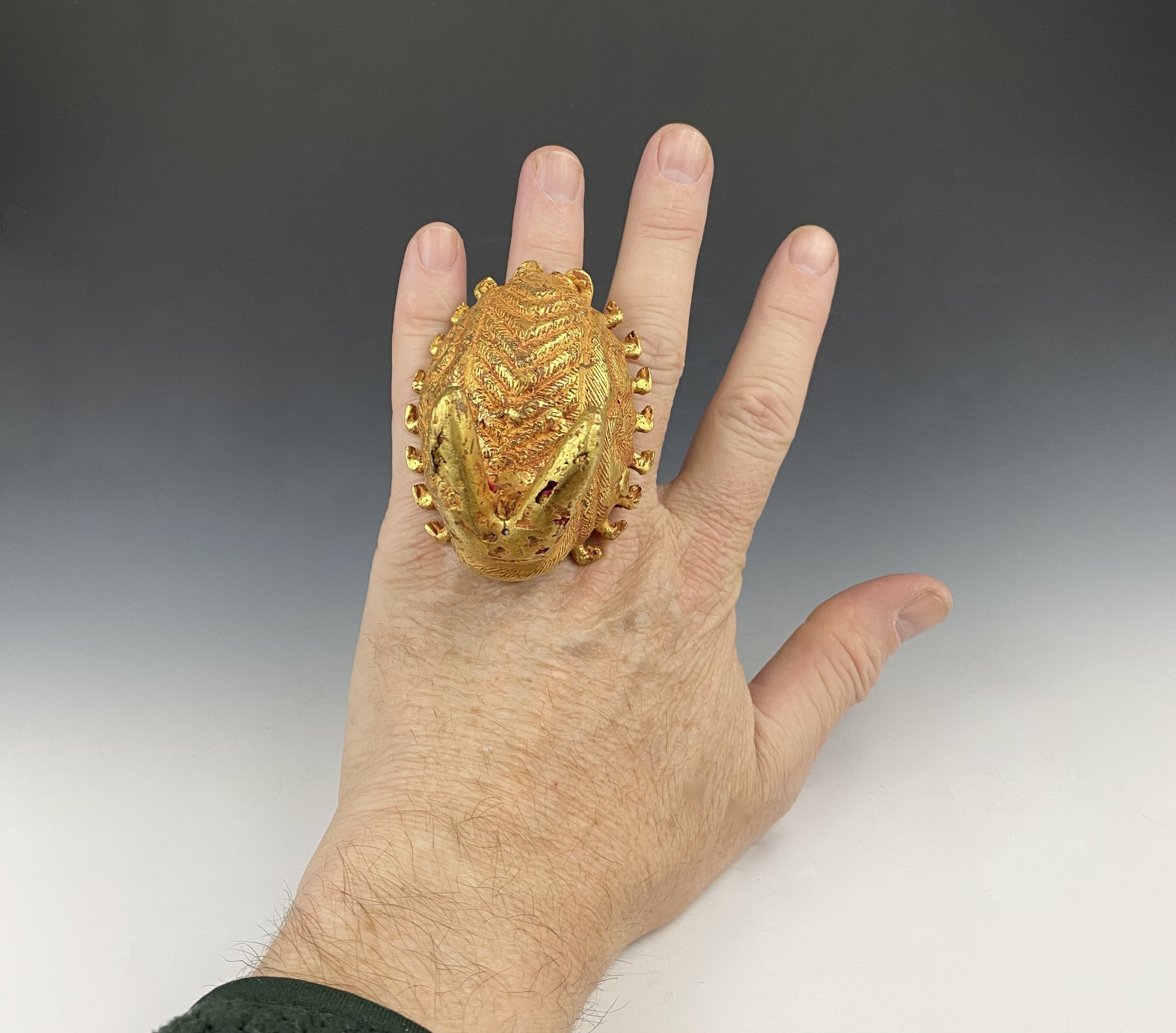

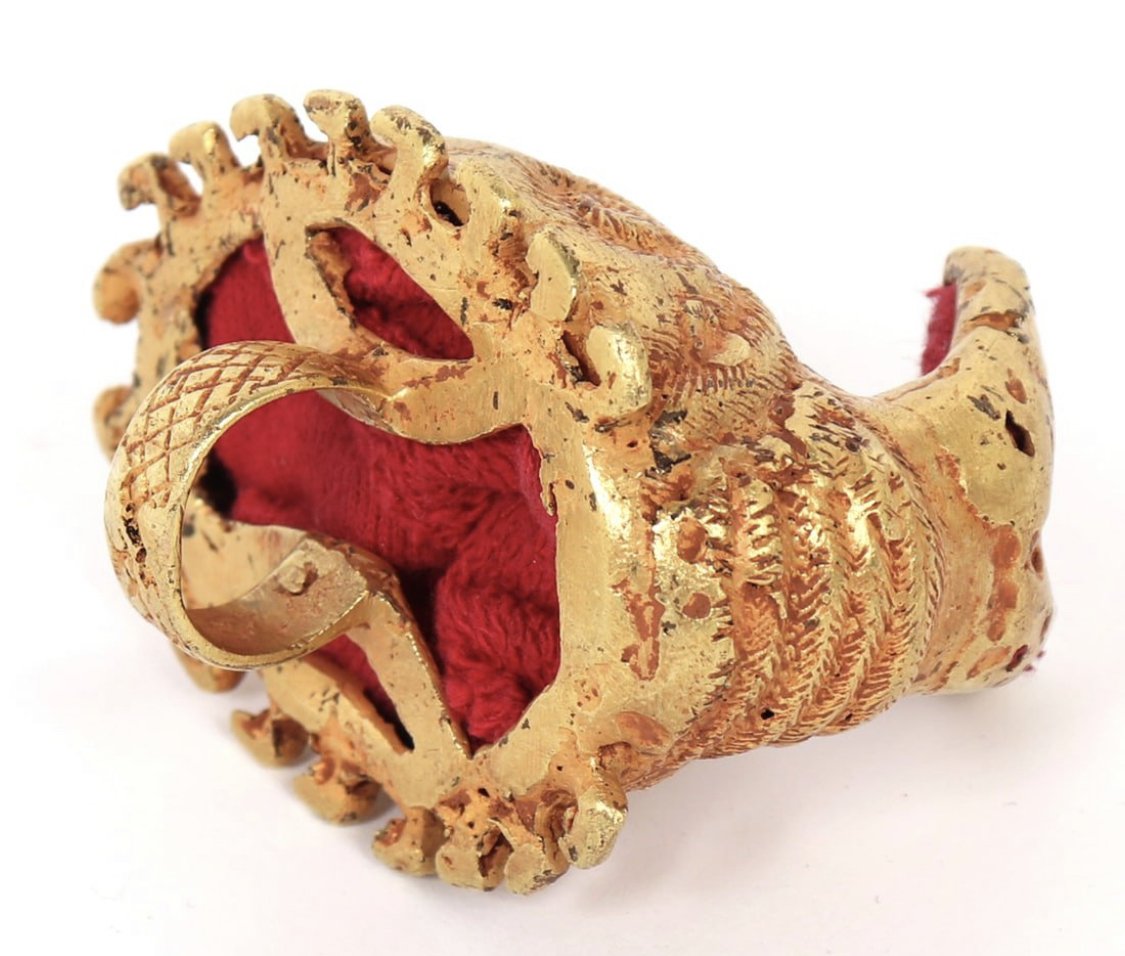
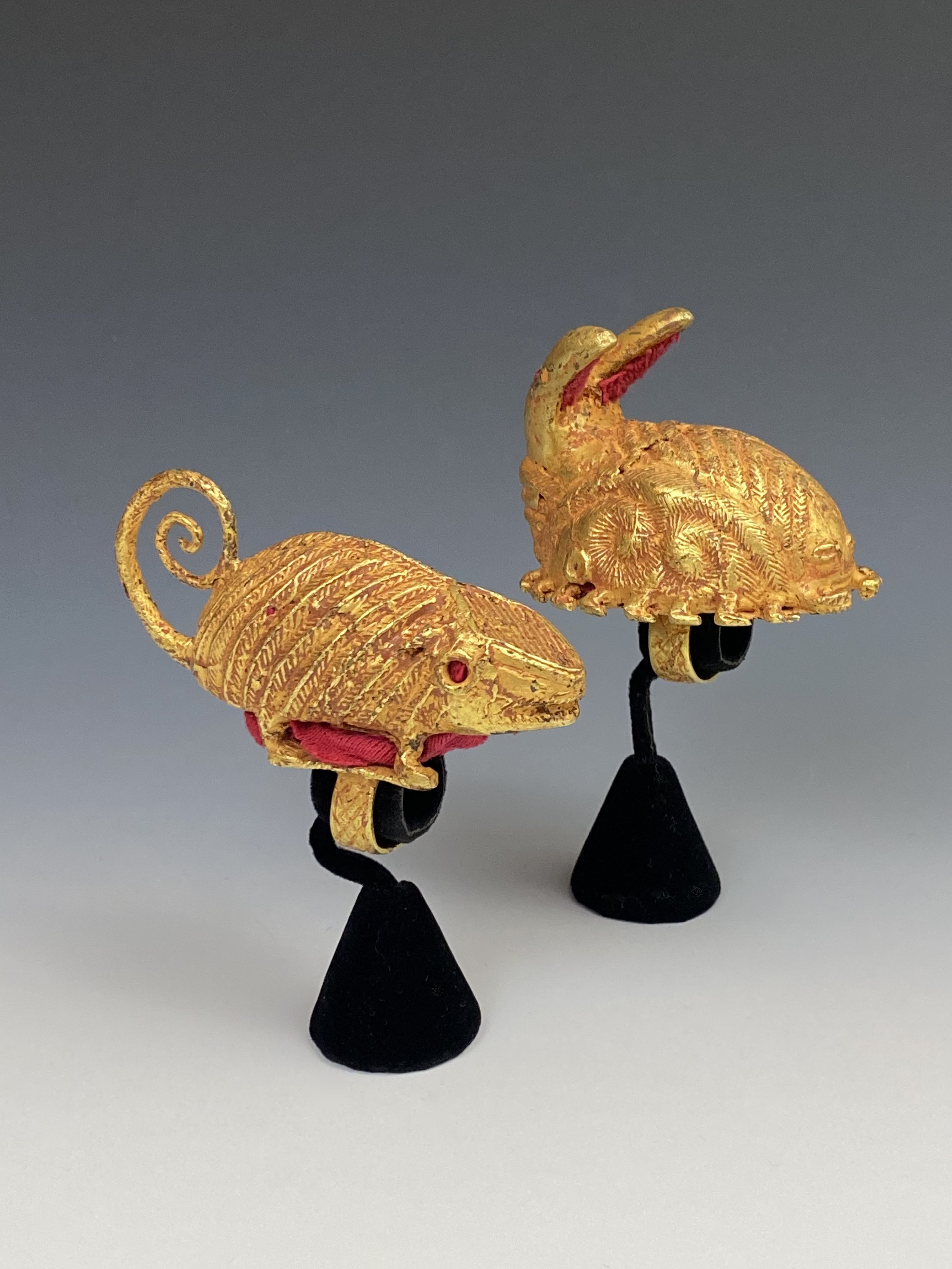

Another colossal Asante gold chief’s ring “mpetea” with the image of a chameleon, 2 3/8” H x 3 3/4” L. Proverb: “The chameleon can only change the color of the clothes he is wearing, not those in his box,” meaning that one can deal only with the immediate environment, only with the problems at hand. This is a warning against trying to exceed one’s own abilities. Ex collection of Dr. Arikana Chihombori-Quao and Dr. Nii S. Quao. Dr. Arikana Chihombori-Quao was the African Union’s Ambassador to the United States.
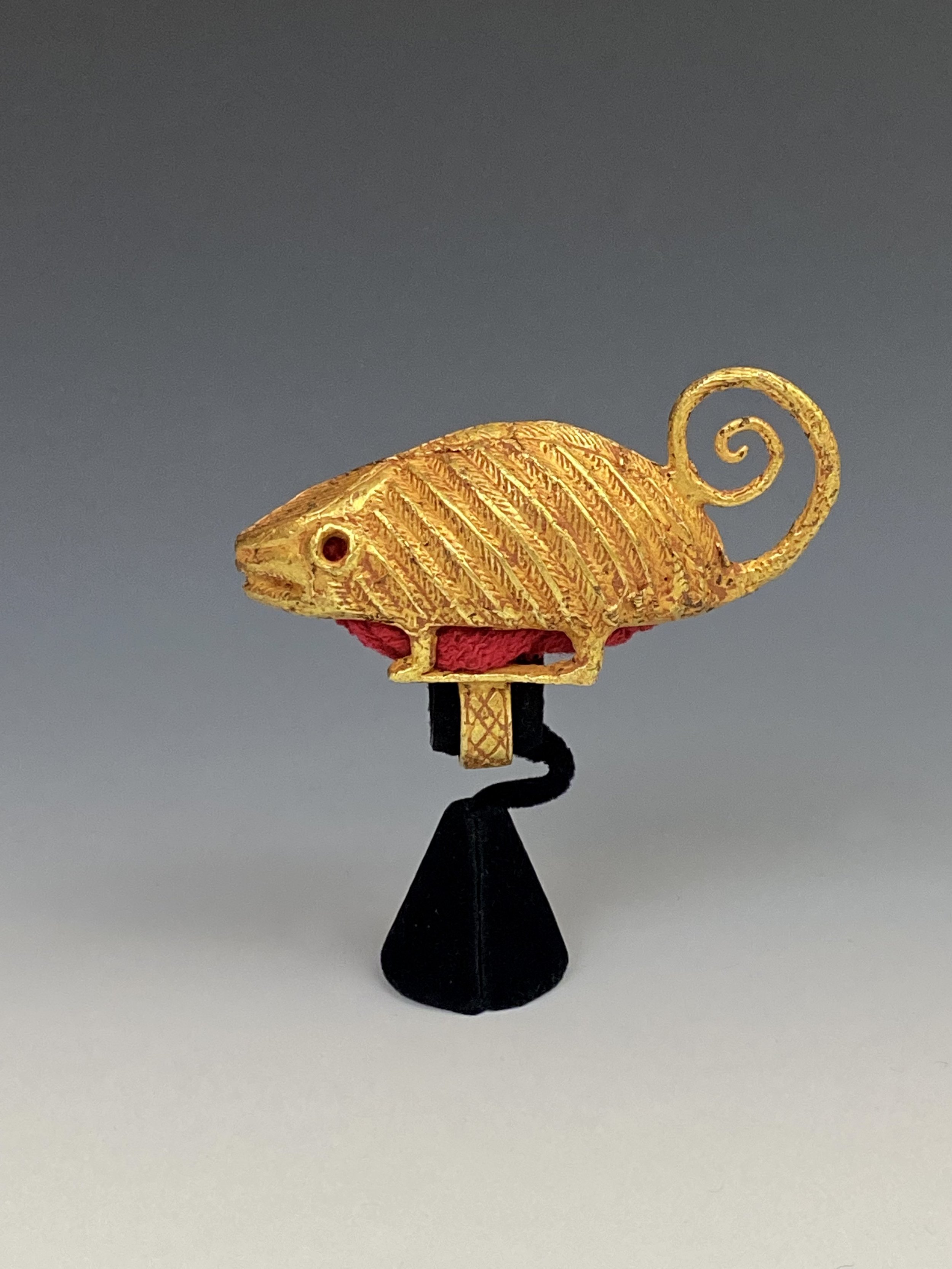
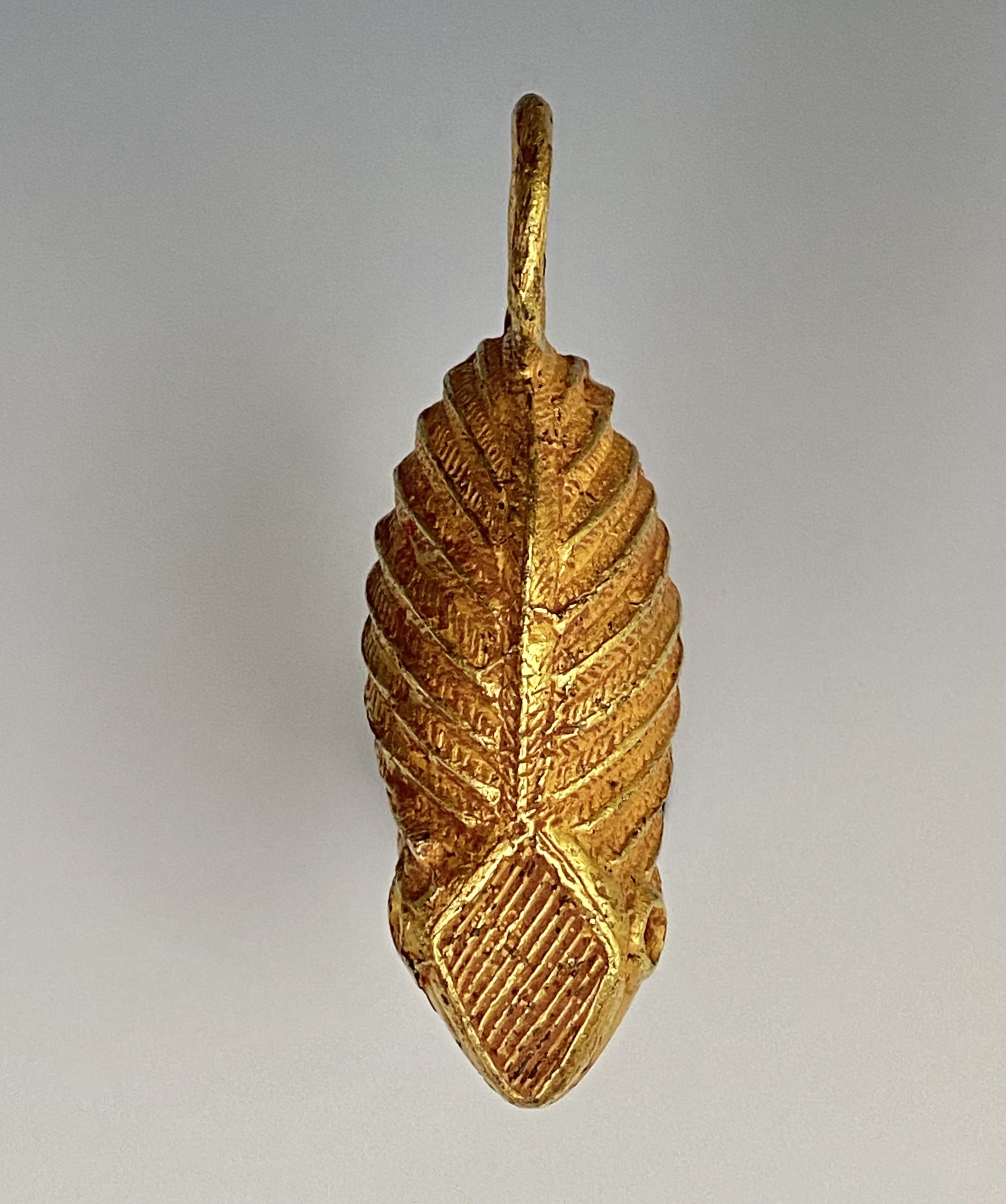


Hairpin, Asante, Ghana. Gold alloy. H 8.5 cm. The pin consists of three birds on a flower. The motifs shown always point to people, animals or objects that allegorically stand for praiseworthy qualities and sayings. Hairpins were generally believed to have originated from European influence, particularly Victorian fashion. The filigree technique used here is of exquisite quality. The British museum writes “Hairpins were inspired by Europeans and first became popular among the Fante communities on the coast in the early nineteenth century. These pins were worn by women fixed into their elaborately plaited hair or sometimes, in the case of Fante women, into elaborate wigs made of horsehair.” ex Dr. Andreas Vontobel (1931-2011), Waltalingen

Akan pendant bell, cast gold alloy. 3.5 cm. From the estate of René David. Exhibited: Musée International du Golfe de Guinée, Lomé, Togo (2005-2011). “There are two types of bells in common use in Asante: the flared-lip, open type with attached clapper always associated with state stools and often seen in miniature versions as an ornament, and the smaller, spherical, closed ‘sleighbell’ or crotal type with a loose stone or bit of metal put inside through the slitted opening in the bottom to provide its noise-maker. Bells, of the first type, were customarily bound to ancestral stools in order to call the spirits of the departed, and those attached to the Golden Stool were rung to summon the Asante people. Miniature representations of manacles and bells were also cast in the form of gold-weights, strung as composite elements onto ornaments and appeared as part of the decorative schemas of cast brass kuduo vessels. Bowdich states in his published account that ornaments such as this, along with other beads and cast gold items, were strung on bracelets and anklets to protect the wearer from harm.”- source: British museum curator’s notes.
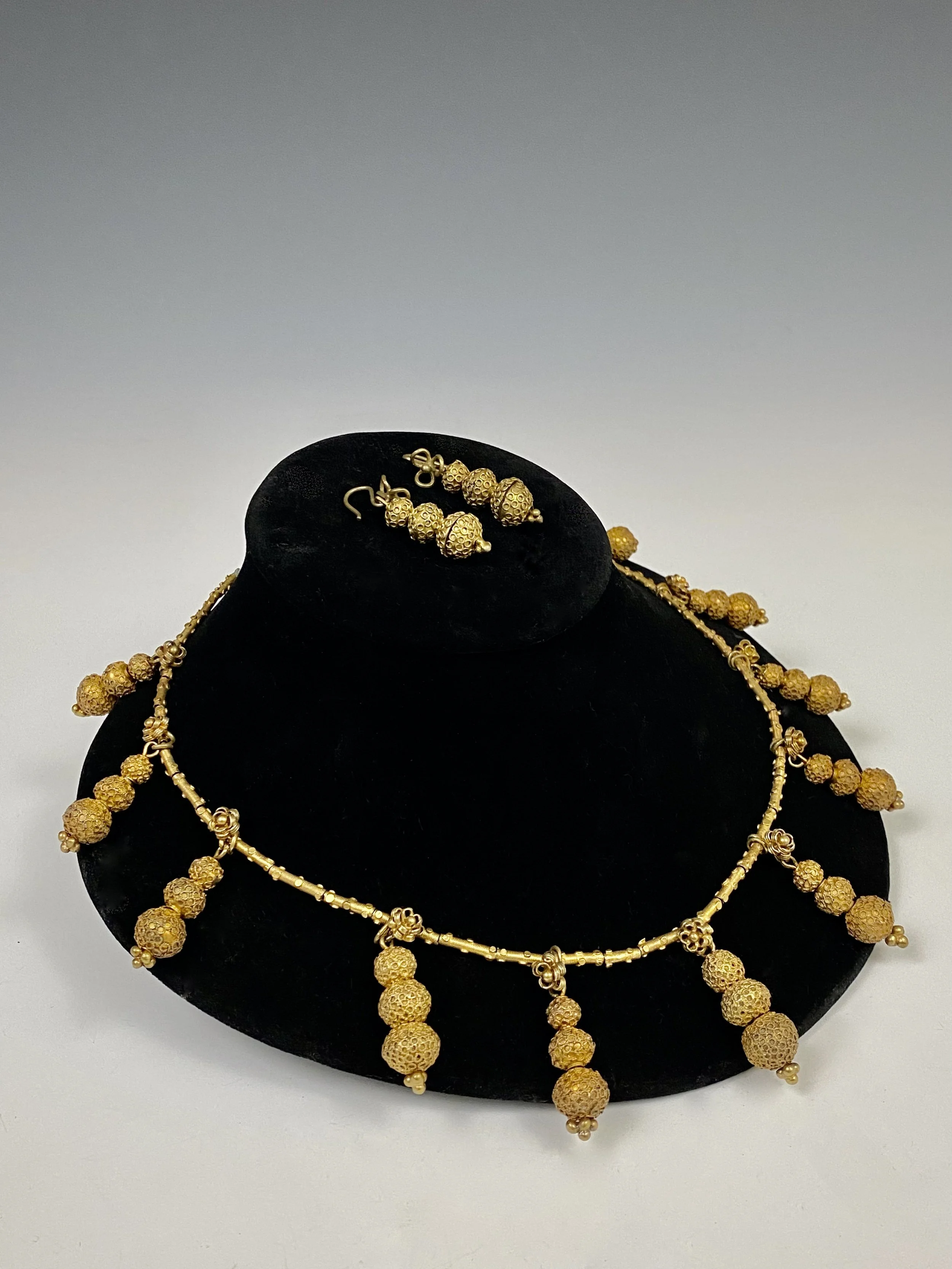
An Akan (Côte d’Ivoire/Ghana) gold/silver alloy demi-parure. This design was influenced by Victorian fashion. It consists of a necklace strung with numerous tubular beads and suspended triple spherical bead pendants, together with a matching pair of earrings. The interest in Victorian designs continued into modern times making the dating of such items more difficult. 19 inches long. The earrings measure approximately 1 3/4 inches long. A measured spectrum analysis was performed and concluded that it consists of 79.10% silver, 17.28% gold, and 3.62% copper. From the estate of Olga Hirshhorn

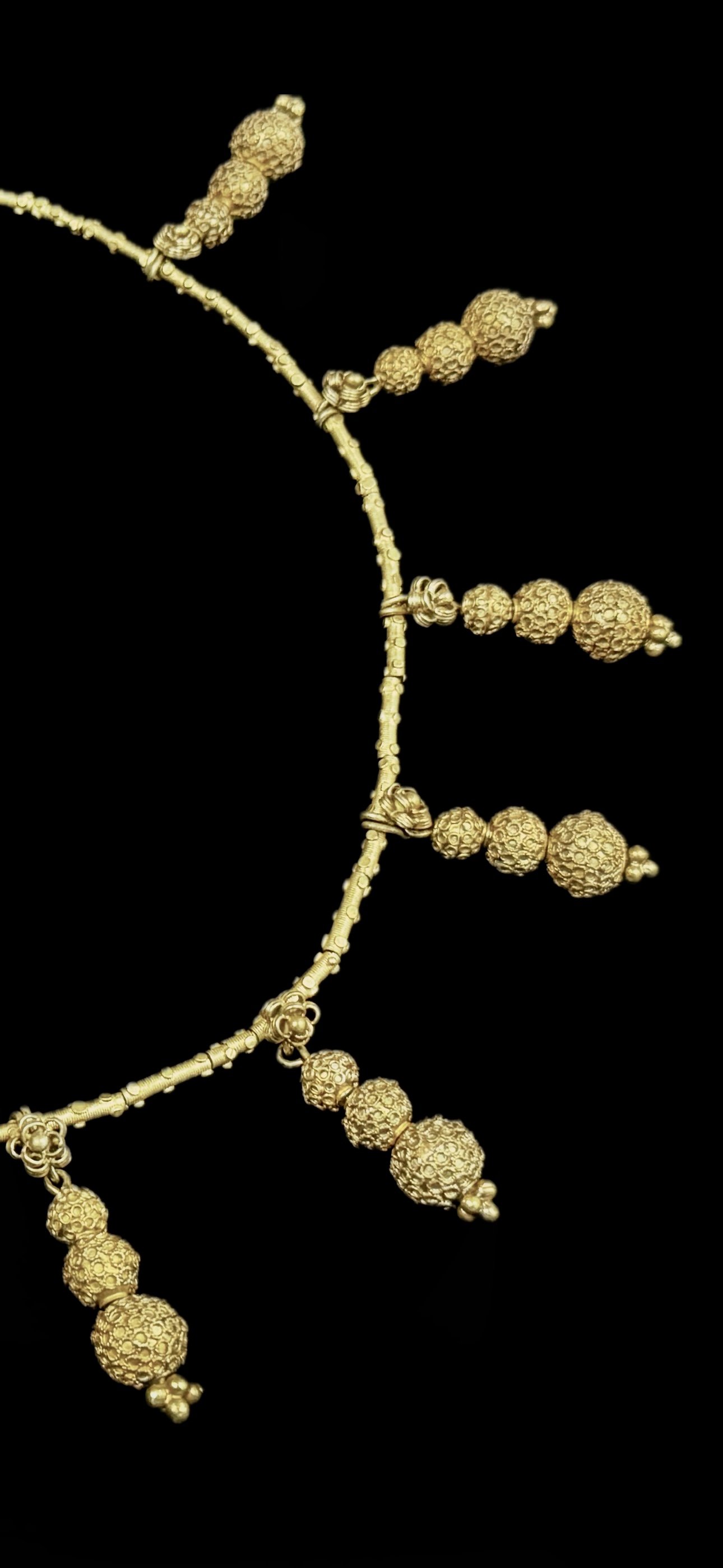
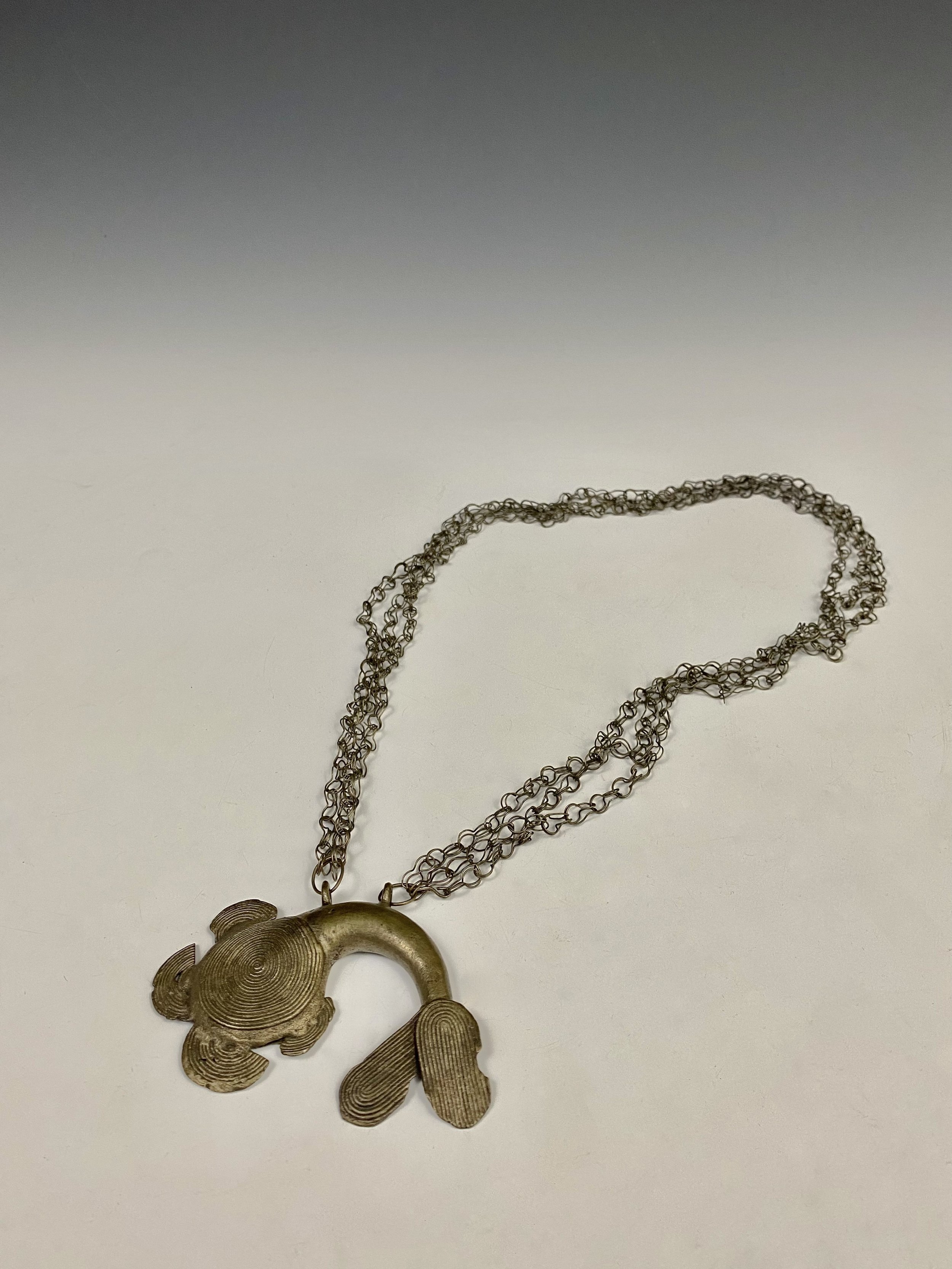
Akan three-stranded chain with mudfish pendant. Silver alloy. Associated proverb: "When the mudfish swallows anything, it does so for its master" (crocodile) that is, what is good for his subjects is good for the chief". Provenance: Zemanek-Münster, Würzburg, Germany, Roland Hartmann, St. Gallen, Switzerland (1922-2007), René David, Zurich Switzerland (1928-2015) According to Doran Ross in The Arts of Ghana, a similar example of a silver mudfish amulet necklace with a similarly made chain is thought to be MAMPRUSSI? from the Northern regions of Ghana. Although collected as an Akan piece, it may have a different origin.
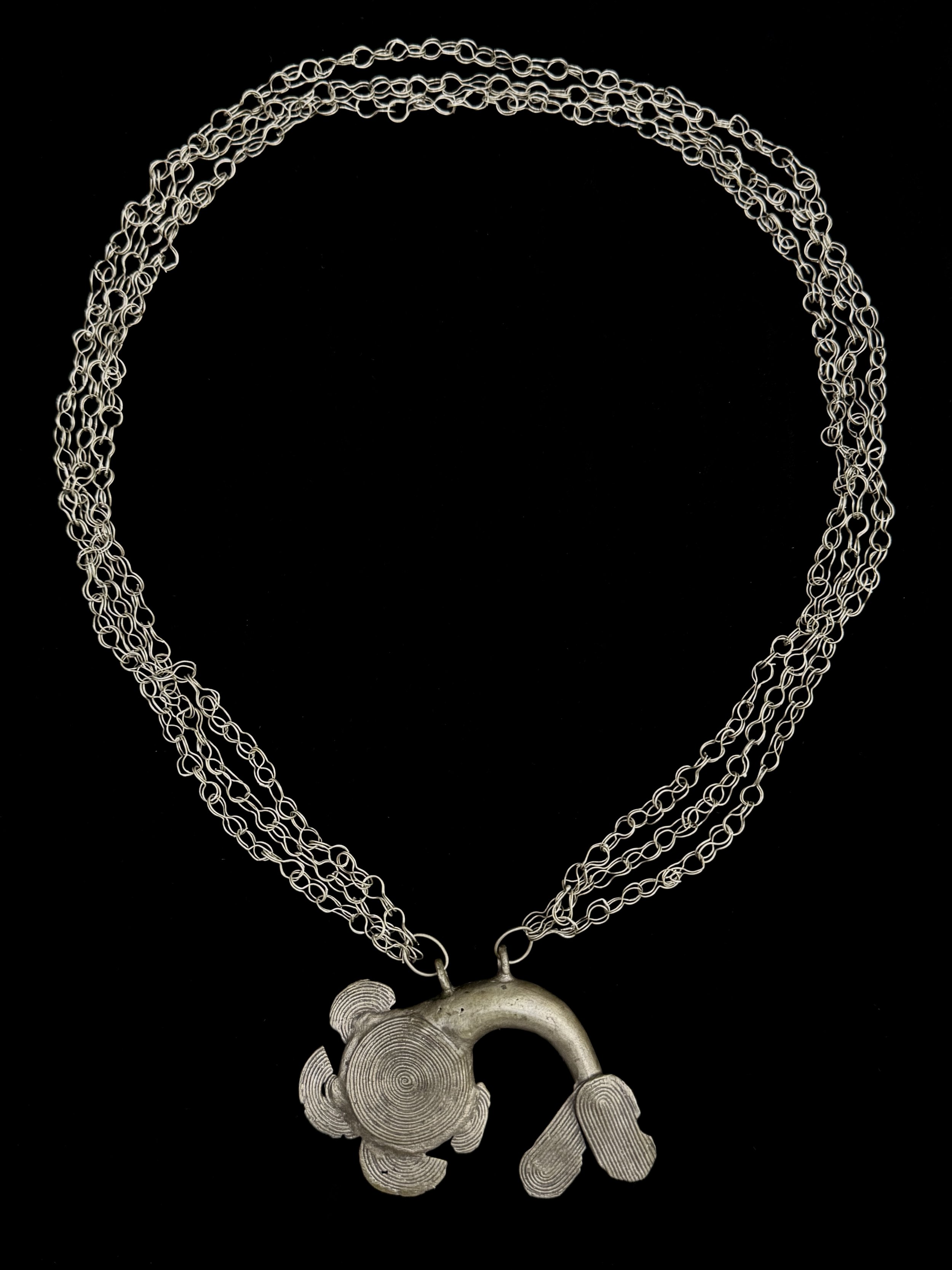
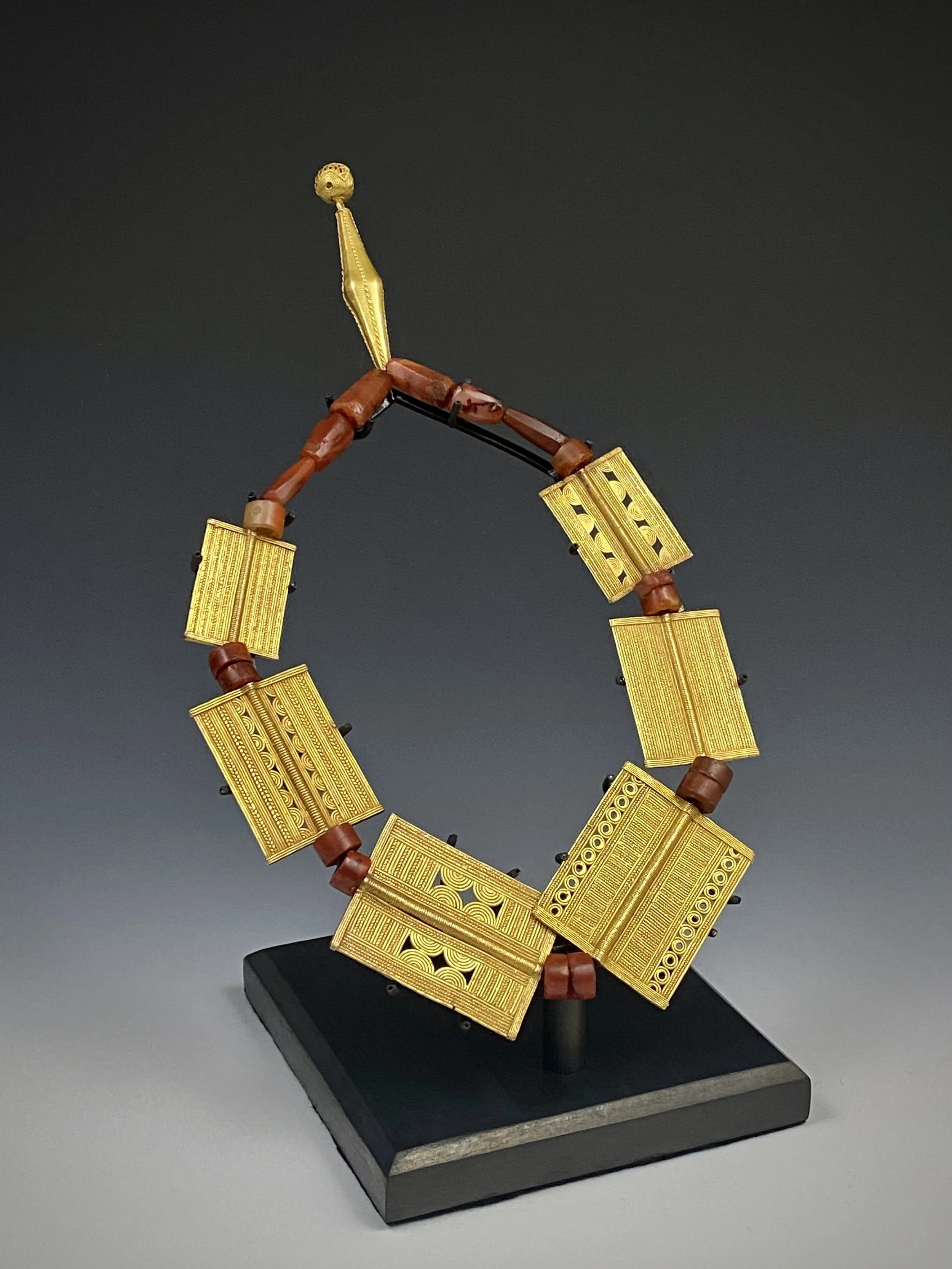
Although these beautiful and intricately cast beads were collected in Ghana, the design and technique points to the Baule or Lagoons goldsmiths of Côte d’Ivoire. That said, similar designs have been produced in the neighboring coastal Akan states of Ghana. The rectangular beads each have a name according to the design pattern with some referred to as “srala” or “bamboo door”, “Alondra” or “chicken feather”, “alekue” or “the cups on an awale board”, “Allie waka” or “knife handle”, “akwatika sinbui” or “the back of the tortoise”, “jomo owie” or “dog’s bone”, “besin besin” or “back to back”, and “kokoyaka” or “taro roots” or “taro foot”. “Shield” is another common design for the rectangular beads. The largest of these rectangular beads is 6cm x 5cm and the smallest is 4cm x 3cm. The bi-conical bead (8cm L with round bead) hangs to the back and terminates with a round bell shaped bead. Strung with carnelian stone beads collected in Bondoukou, Côte d’Ivoire.
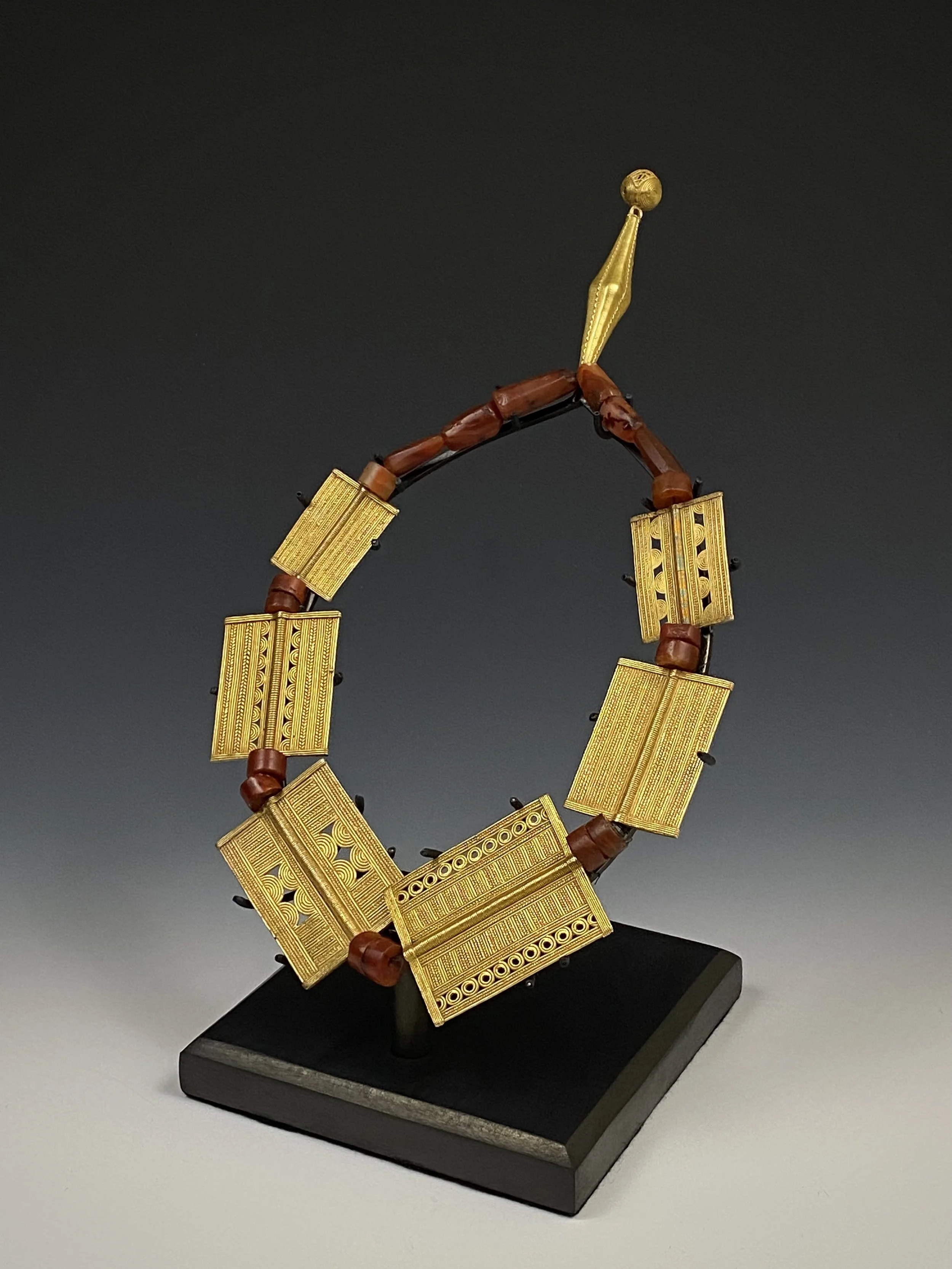
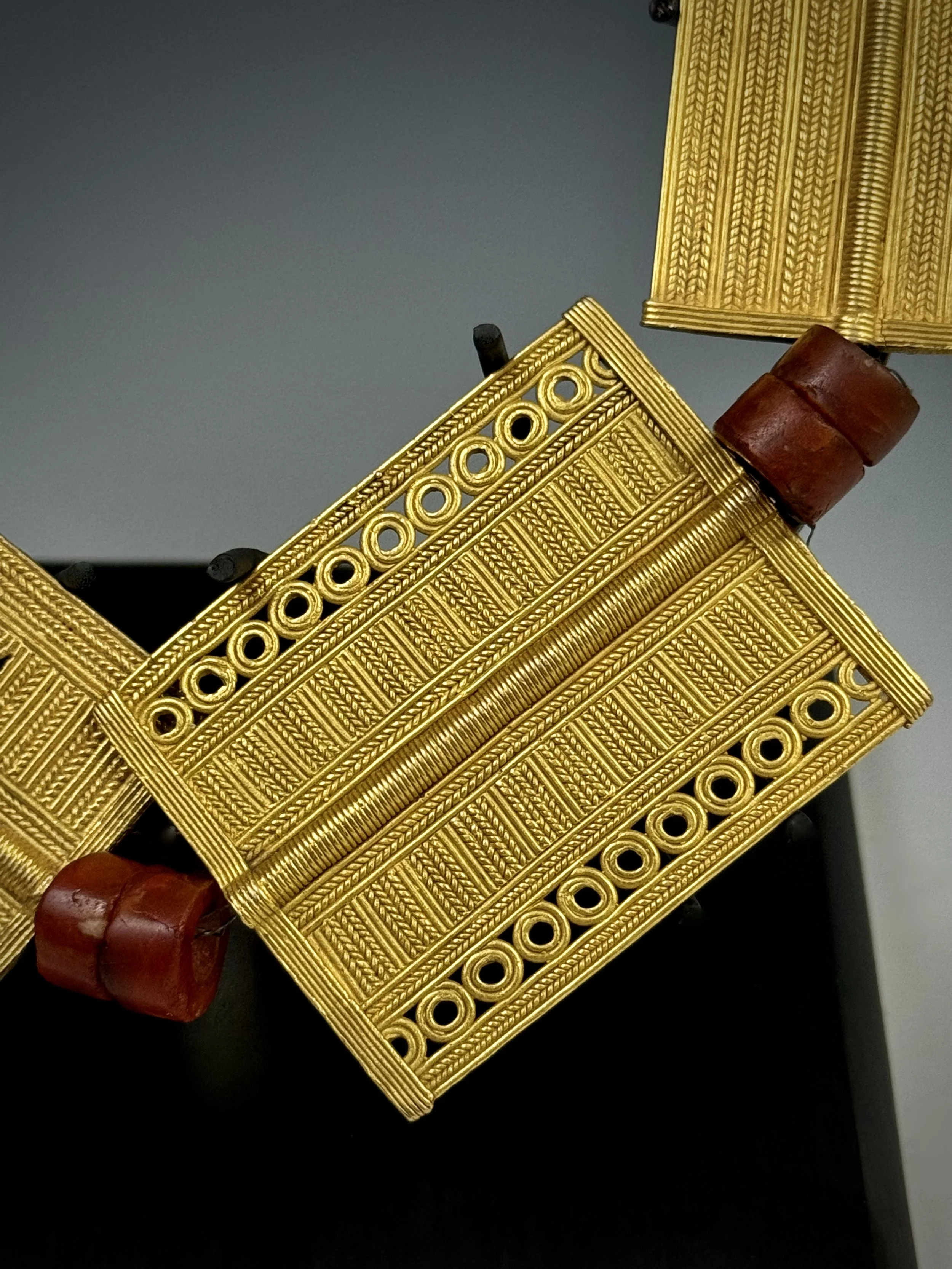
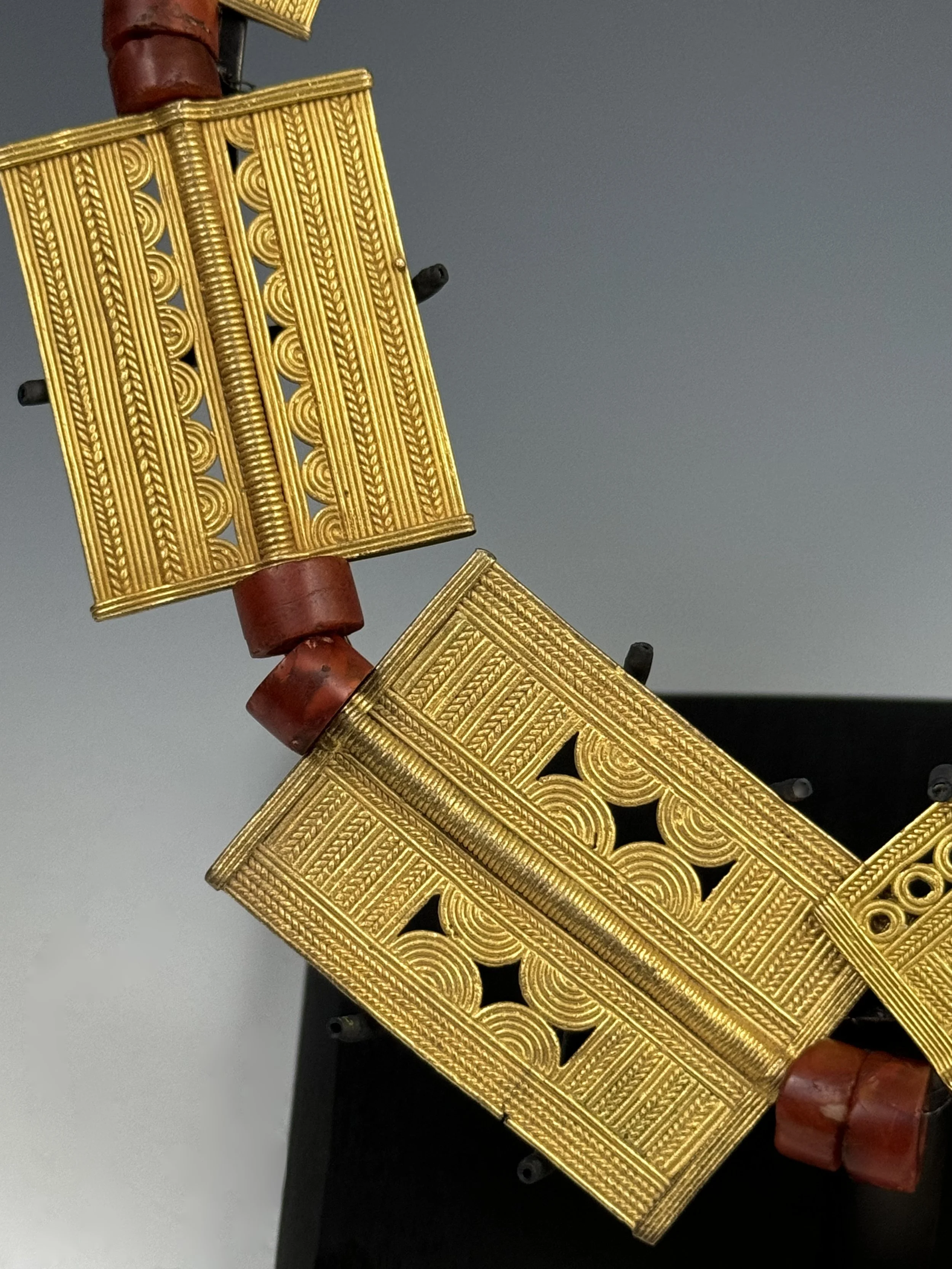


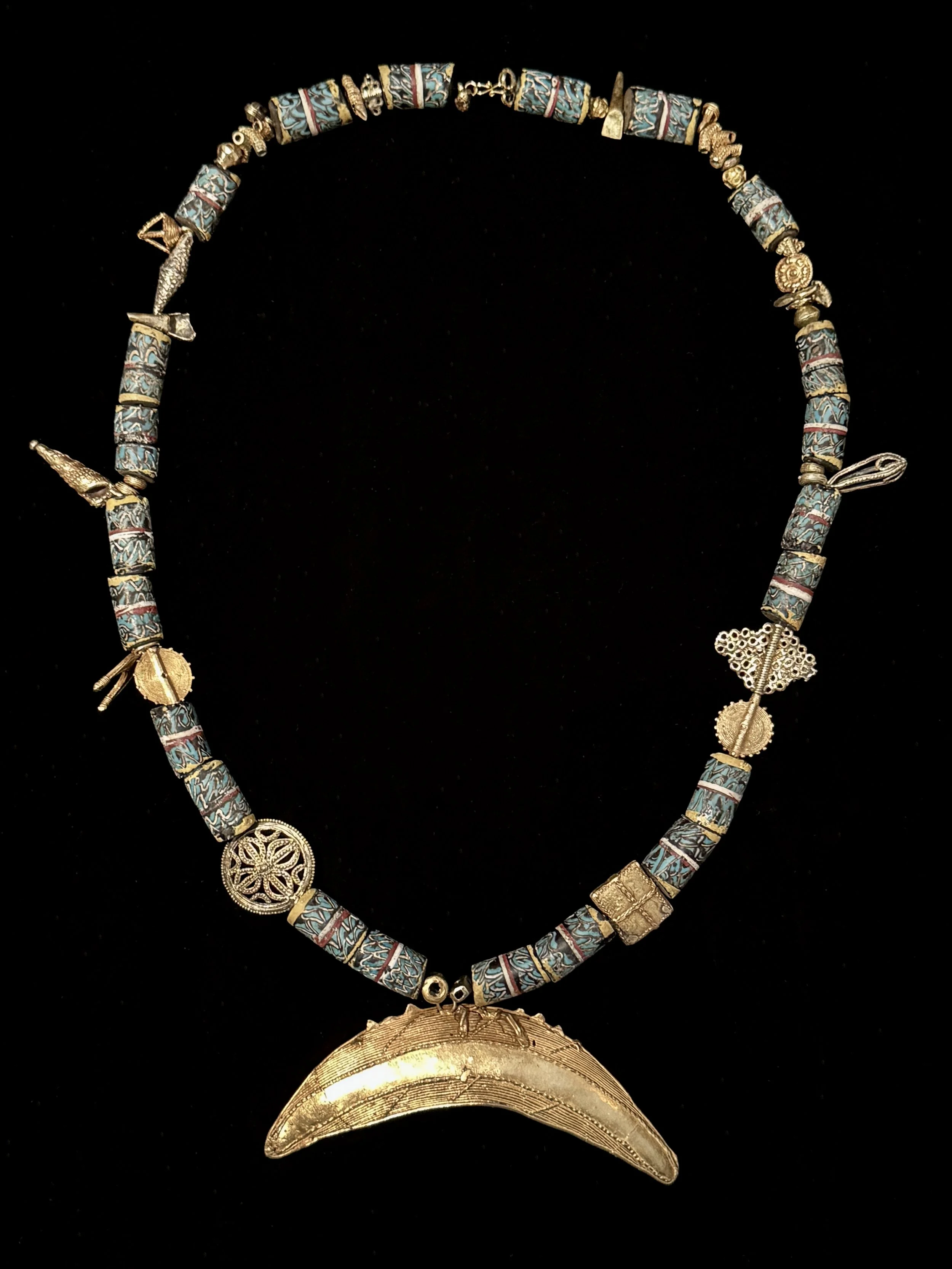
An exceptional Akan necklace from Ghana/ Côte D’Ivoire consisting of gold beads (10K-18K) with a downward pointing gold alloy crescent moon shaped pendant. Rare large glass Venetian cylindrical beads (1850-1920) alternate with the gold beads. The majority of the gold beads are cast with a few fabricated from sheet gold and formed and decorated with repoussé. Most notably are the two Akan images of human teeth, two natural gold nugget forms, sea shells, sun discs, and over 37 individual smaller gold beads in various forms. Necklace 30”. Pendant 4 3/4” L. Ex collection of Dr. Arikana Chihombori-Quao and Dr. Nii S. Quao. Dr. Arikana-Quao was the African Union’s Ambassador to the United States.
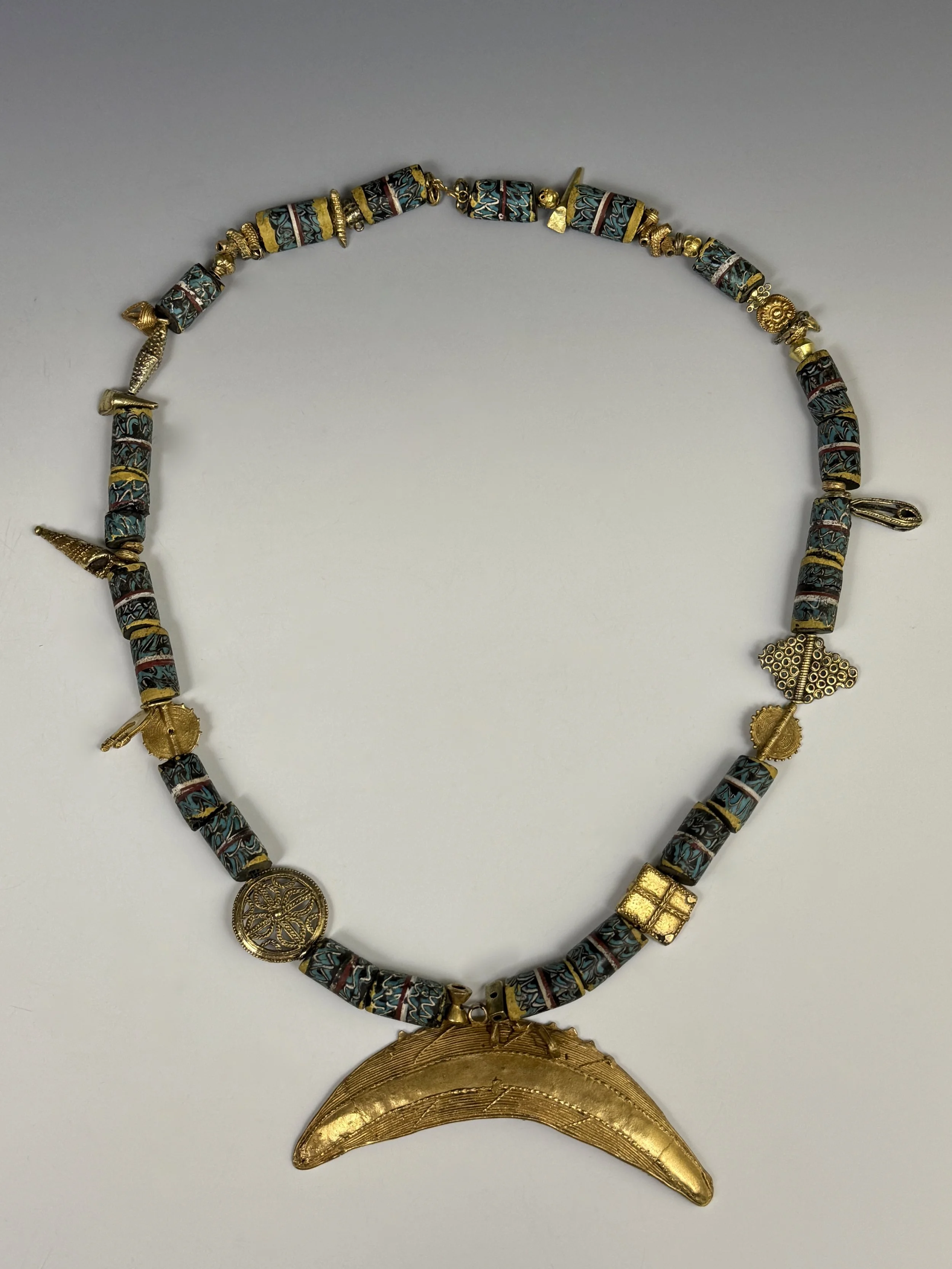
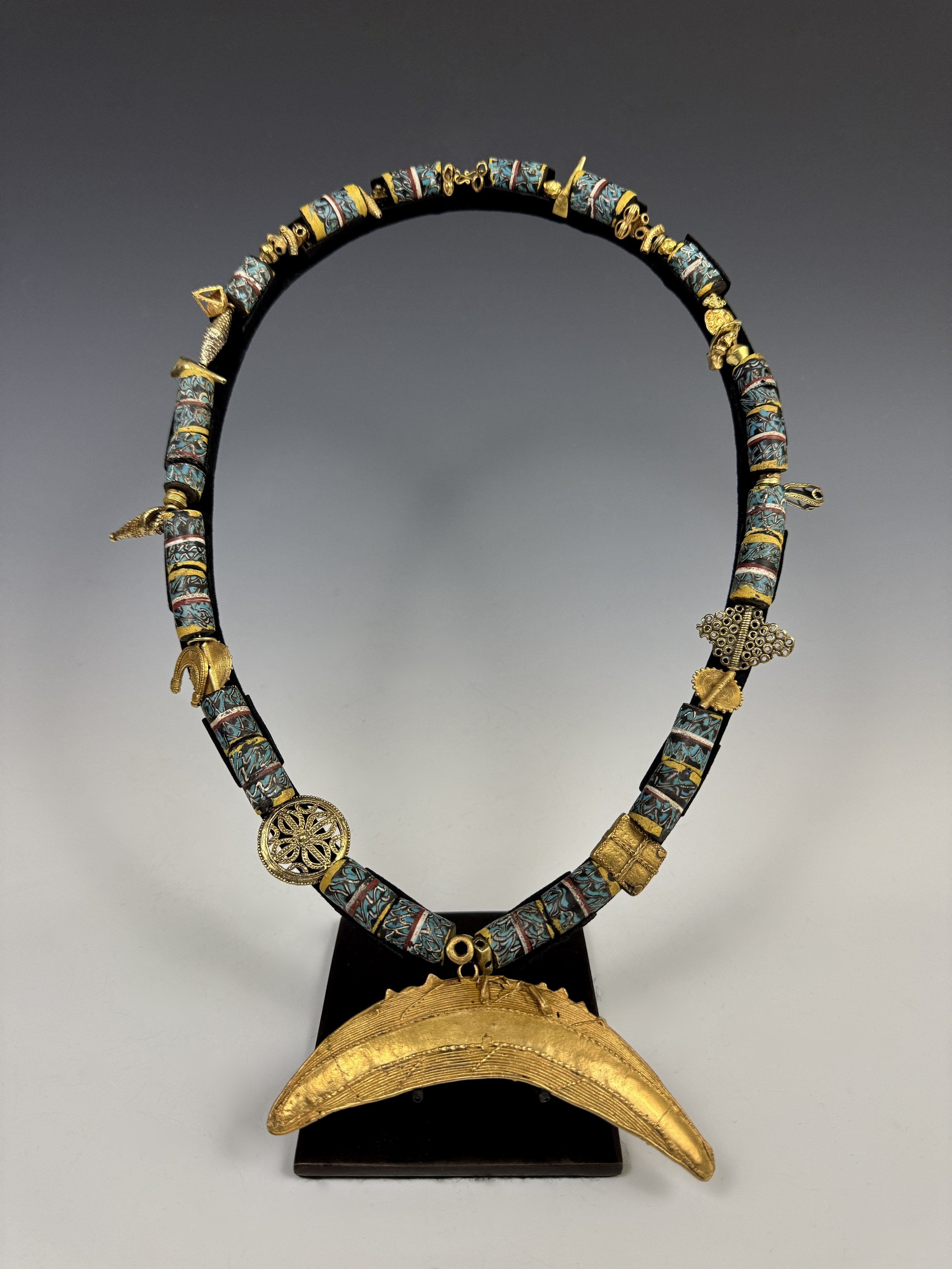
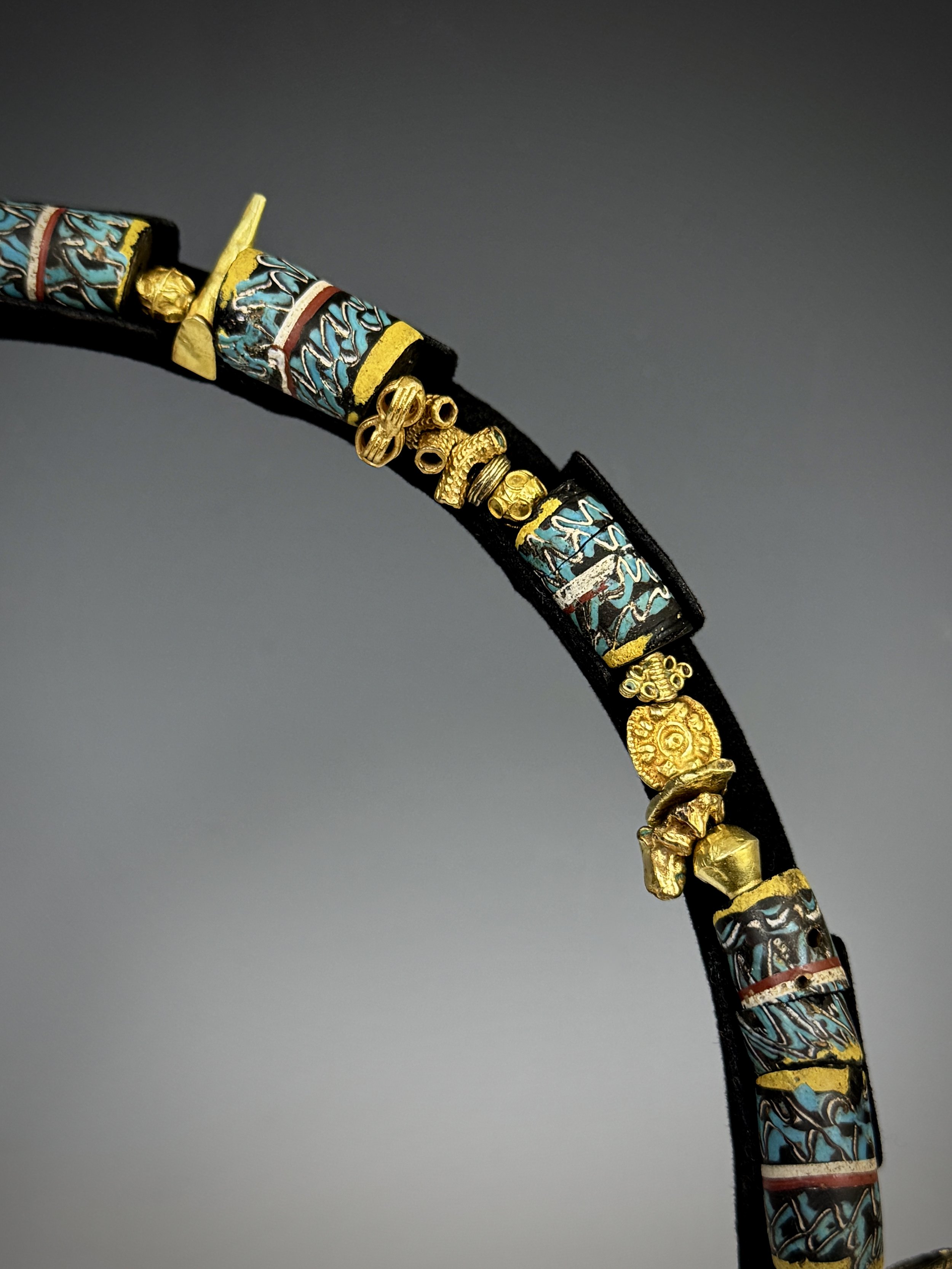

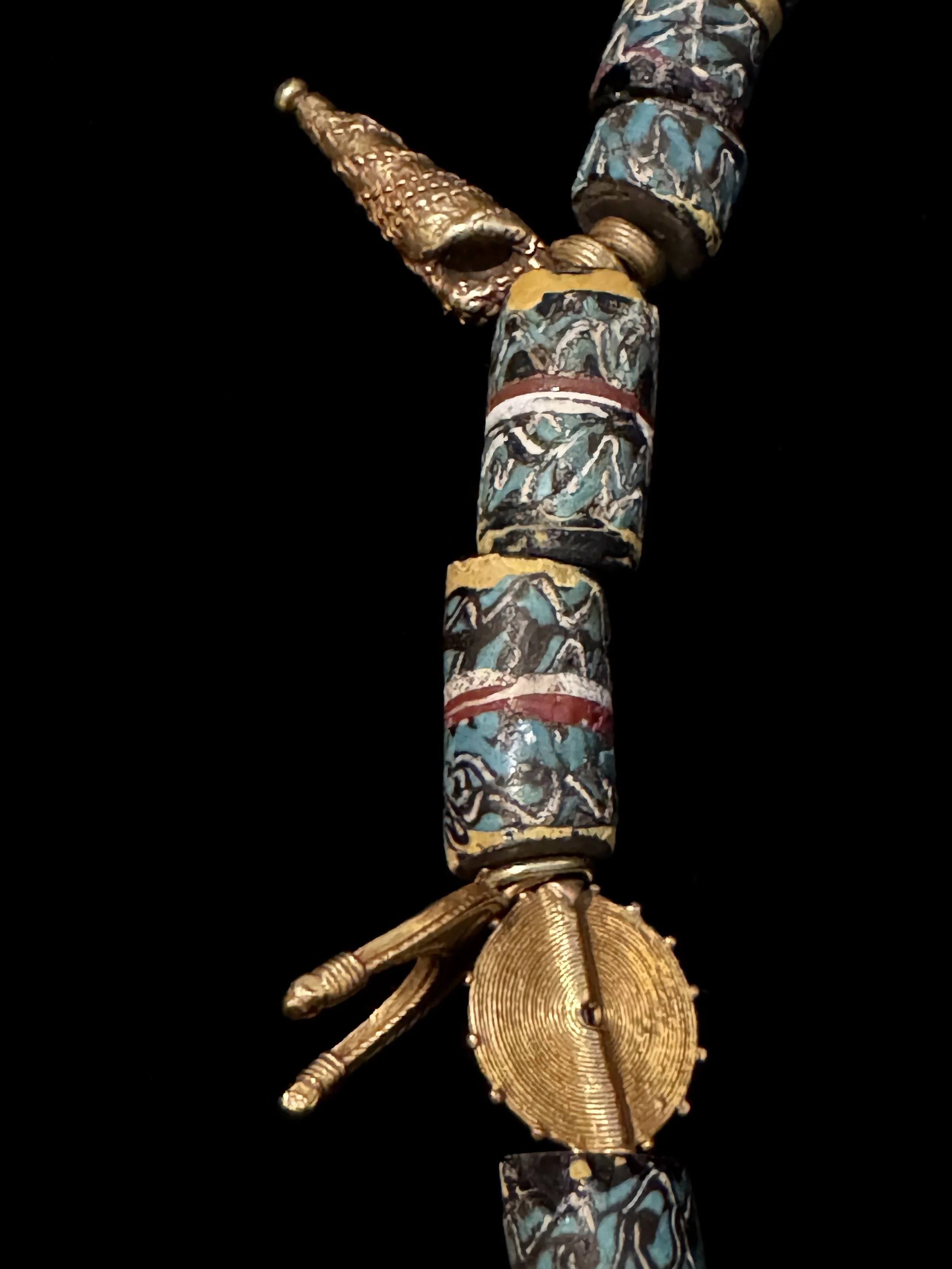
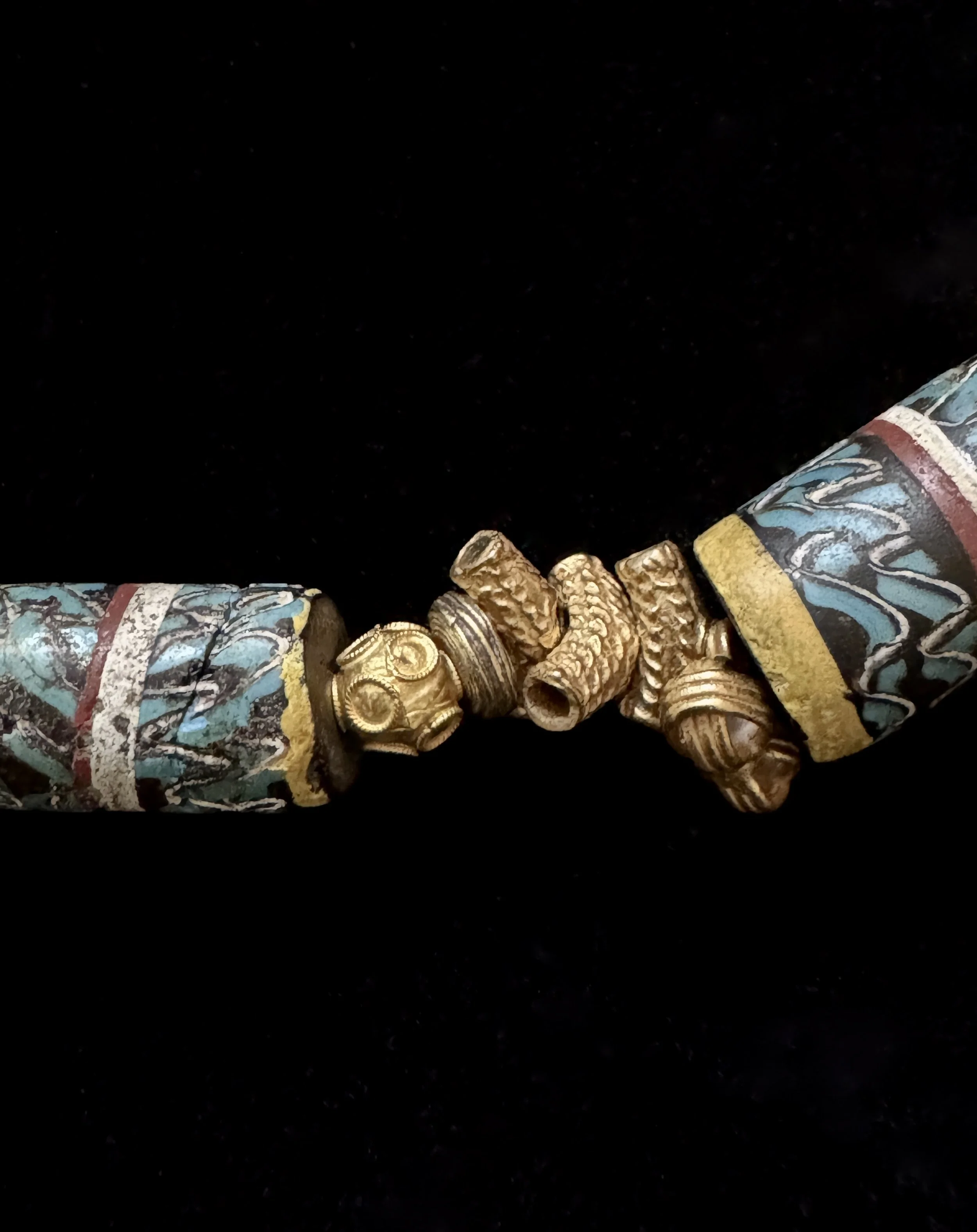
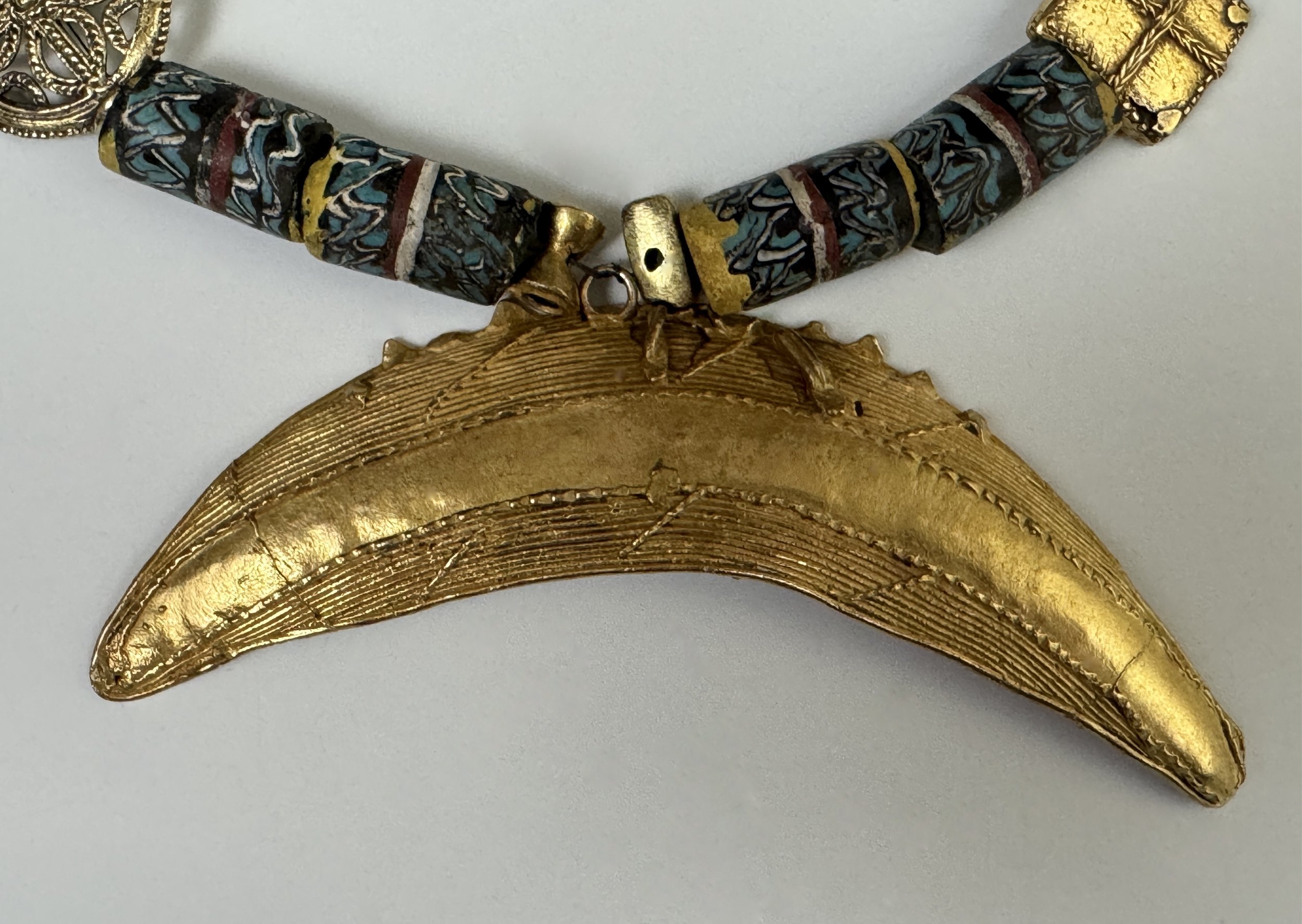

An Akan silver/gold alloy pendant with a very long multi link chain featuring a large depiction of a man picking cacao pods from a tree (321 grams). Size 74" L, pendant 4" H. Silver alloyed with gold is often referred to as "green gold". When it naturally occurs, it is called electrum. This pendant may not be pleasing to the western eye but it held a lot of prestige to the owner at a time when great fortunes were made from the introduction of Cacao in Ghana. I have only seen one other example with remarkable similarities to this pendant in size and design which is part of the Barbier -Mueller collection in the African Gold Museum in South Africa (see image below).

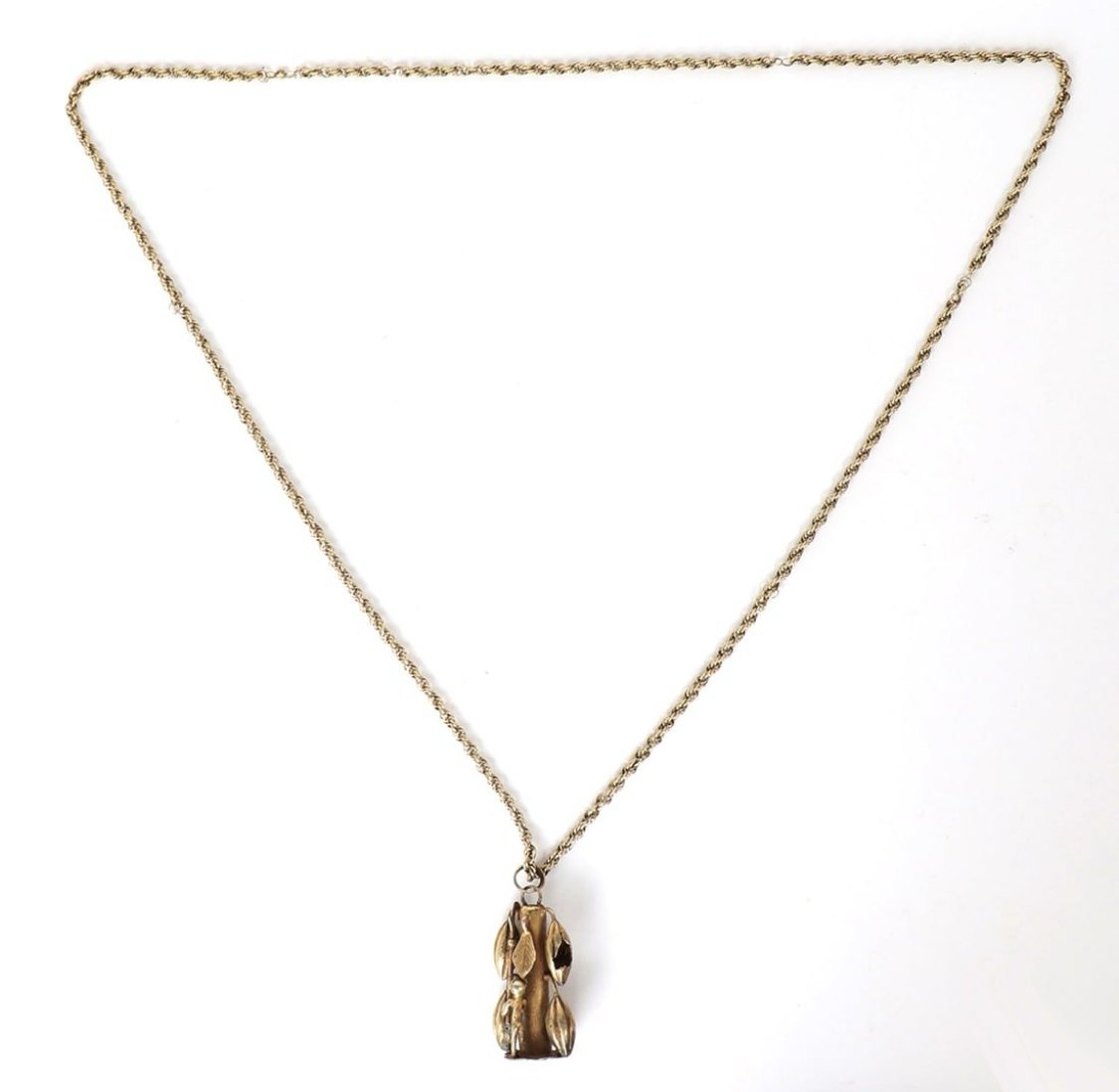
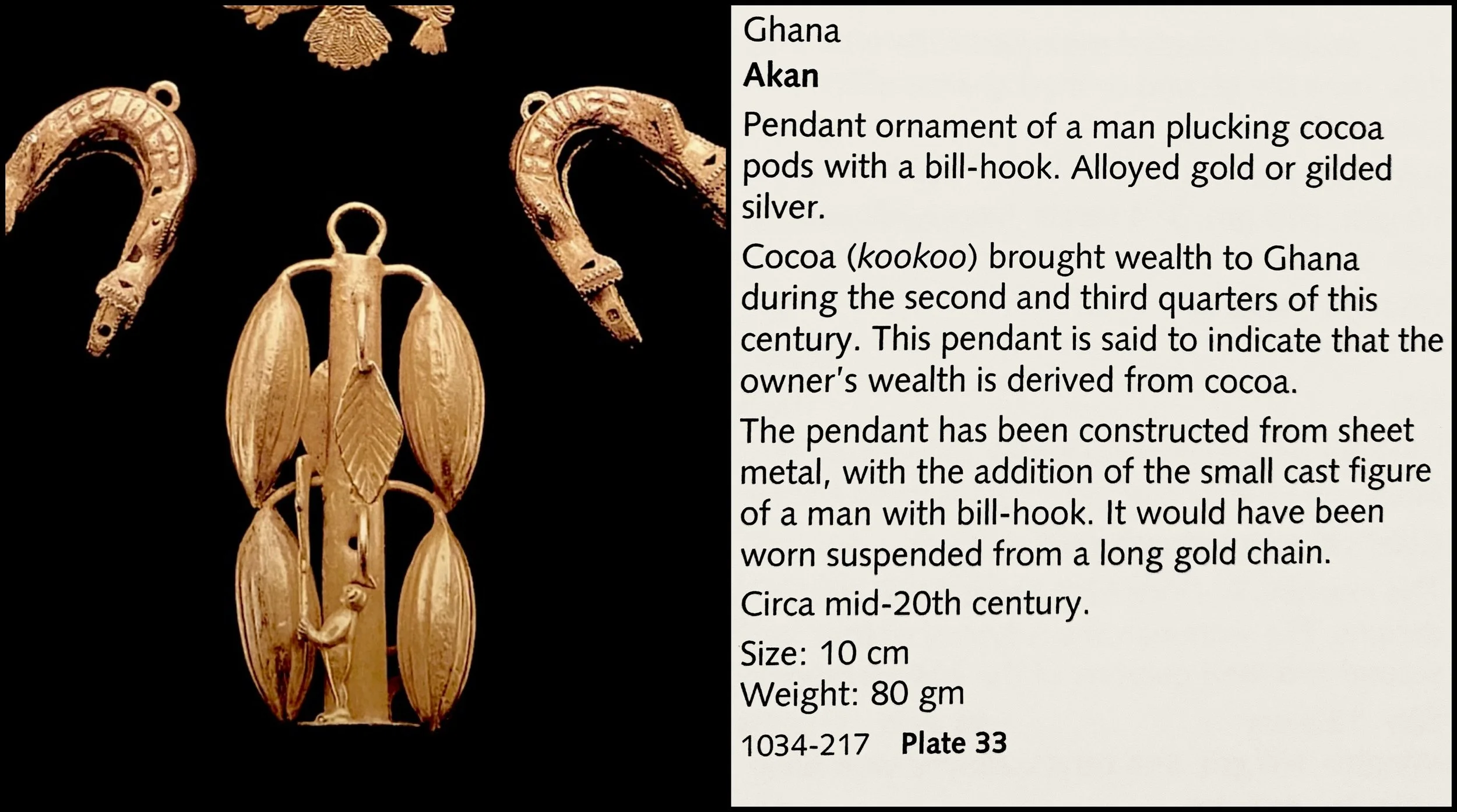
A remarkably similar pendant from the Barbier- Mueller collection in the Gold of Africa museum, South Africa.

A group of Akan pendants from a period when great wealth was brought to individuals in Ghana and Côte d’Ivoire with the introduction of the crop Cocoa. In Ghana, cocoa was so prosperous, it was often referred to as “sika dua” or “gold tree” (money tree). The imagery is of cocoa pods and tools used in the cultivation, harvesting, and preparation of cocoa (such as the bill hook, cocoa harvesting knife with its curved blade, and a cutlass). As prestige jewellery items, they display the success and source of the individual’s wealth.
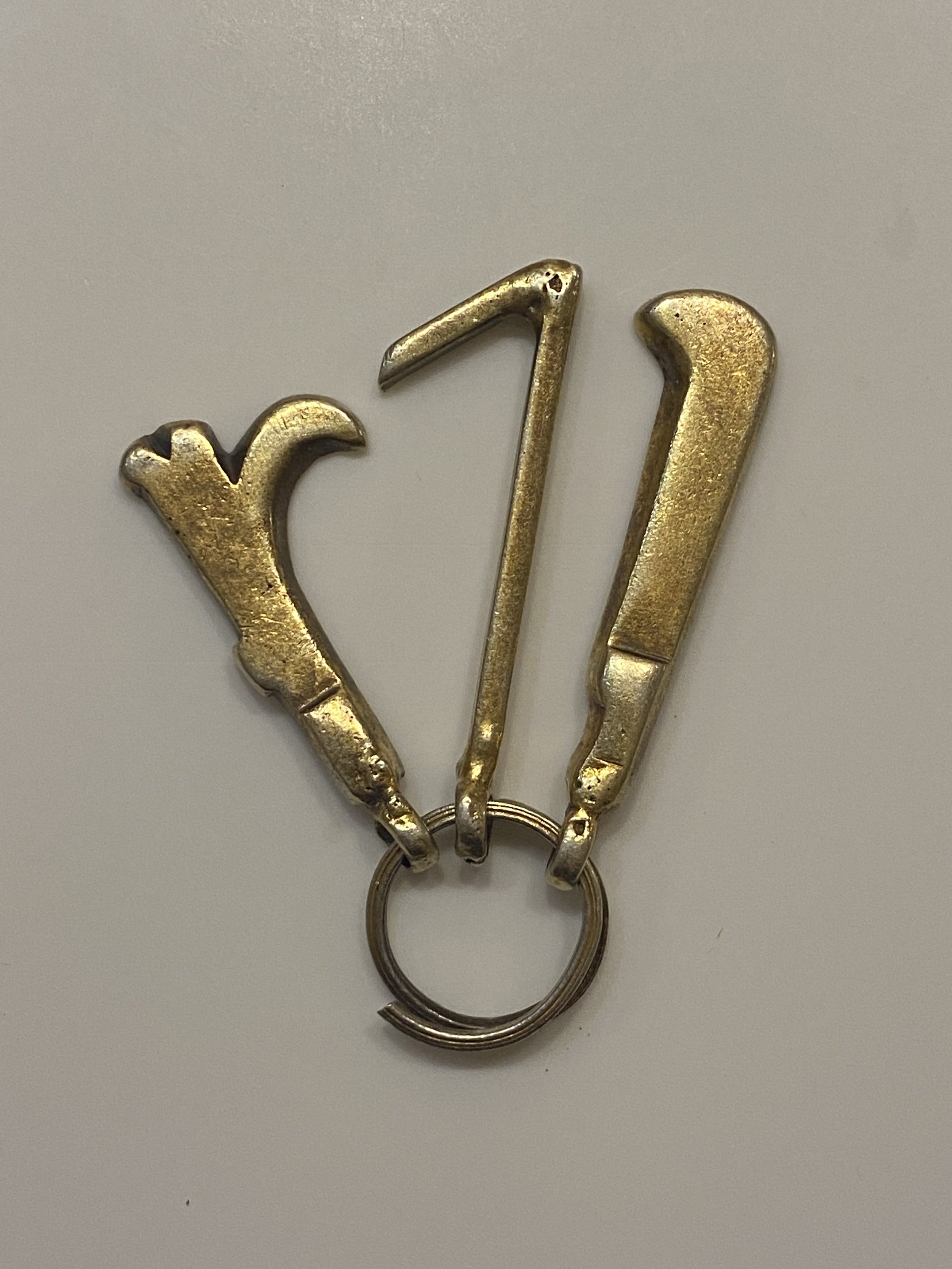
Three Akan pendants of a bill-hook, cacao harvester’s knife, and a cutlass. Gilded silver and gold alloy.